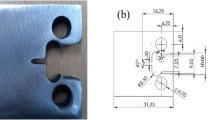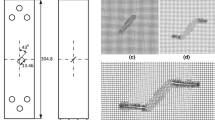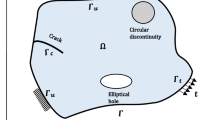Abstract
The present work deals with the fatigue crack growth simulation of alloy/ceramic functionally graded materials (FGMs) using extended finite element method (XFEM). Various cases of FGM containing multiple inhomogeneities/discontinuities along with either a major edge or a center crack are taken for the purpose of simulation. The fatigue life of the FGM plate is calculated using Paris law of fatigue crack growth under cyclic loading. The effect of multiple inhomogeneities/discontinuities (minor cracks, holes/voids, and inclusions) on the fatigue life of cracked FGM plate is studied in detail. These simulations show that the presence of inhomogeneities/discontinuities in the domain significantly influences the fatigue life of the components.




















Similar content being viewed by others
References
Bahr H-A, Balke H, Fett T, Hofinger I, Kirchoff G, Munz D, Neubrand A, Semenov AS, Weiss H-J, Yang YY (2003) Cracks in functionally graded materials. Mater Sci Eng A362:2–16
Bordas S, Nguyen P, Dunant C, Guidoum A, Dang H (2007) An extended finite element library. Int J Numer Methods Eng 71:703–732
Carpinteri A, Paggi M, Pugno N (2006) An analytical approach for fracture and fatigue in functionally graded materials. Int J Fract 141:535–547
Carpinteri A, Pugno N (2006) Cracks and re-entrant corners in functionally graded materials. Eng Fract Mech 73:1279–1291
Chakraborty A, Rahman S (2008) Stochastic multiscale models for fracture analysis of functionally graded materials. Eng Fract Mech 75:2062–2086
Comi C, Mariani S (2007) Extended finite element simulation of quasi-brittle fracture in functionally graded materials. Comput Methods Appl Mech Eng 196:4013–4026
Dag S, Yildirim B, Sarikaya D (2007) Mixed-mode fracture analysis of orthotropic functionally graded materials under mechanical and thermal loads. Int J Solids Struct 44:7816–7840
Dolbow JE, Gosz M (2002) On the computation of mixed-mode stress intensity factors in functionally graded materials. Int J Solids Struct 39:2557–2574
Guo L-C, Nado N (2007) Modelling method for a crack problem of functionally graded materials with arbitrary properties-piecewise exponential model. Int J Solids Struct 44:6768–6790
Guo L-C, Nado N (2008) Fracture mechanics analysis of functionally graded layered structures with a crack crossing the interface. Mech Mater 40:81–99
Huang GY, Wang YS, Dietmar G (2003) Fracture analysis of functionally graded coatings: plane deformation. Eur J Mech vol A/Solids 22:535–544
Huang GY, Wang YS, Yu SW (2005) A new model for fracture analysis of functionally graded coatings under plane deformation. Mech Mater 37:507–516
Jin Z-H, Batra RC (1996) Some basic fracture mechanics concepts in functionally graded materials. J Mech Phys Solids 44:1221–1235
Kim JH, Paulino GH (2002) Finite element evaluation of mixed mode stress intensity factors in functionally graded materials. Int J Numer Methods Eng 53:1903–1935
Lee S, Song J, Yoon Y, Zi G, Belytschko T (2009) Combined extended and superimposed finite element method for cracks. Int J Numer Methods Eng 59:1119–1136
Moes N, Dolbow J, Belytschko T (1999) A finite element method for crack growth without remeshing. Int J Numer Methods Eng 46:131–150
Mohammadi S (2008) Extended finite element method for fracture analysis of structures. Blackwell, Oxford
Prabhakar RM, Tippur HV (2000) Numerical analysis of crack-tip fields in functionally graded materials with a crack normal to the elastic gradient. Int J Solids Struct 37:5353–5370
Rao BN, Rahman S (2003) An interaction integral method for analysis of cracks in orthotropic functionally graded materials. Comput Mech 32:40–51
Rao BN, Rahman S (2005) A continuum shape sensitivity method for fracture analysis of orthotropic functionally graded materials. Mech Mater 37:1007–1025
Rao BN, Rahman S (2006) A continuum shape sensitivity method for fracture analysis of isotropic functionally graded materials. Comput Mech 38:133–150
Sukumar N, Chopp D, Moes N, Belytschko T (2001) Modeling holes and inclusions by level sets in the extended finite element method. Comput Methods Appl Mech Eng 190:6183–6200
Ventura G, Budyn N, Belytschko T (2003) Vector level sets for description of propagating cracks in finite elements. Int J Numer Meth Eng 58:1571–1592
Zhang Ch, Sladek J, Sladek V (2004) Crack analysis in unidirectional and bidirectional functionally graded materials. Int J Fract 129:385–406
Zhang Ch, Sladek J, Sladek V (2005) Antiplane crack analysis of a functionally graded material by a BIEM. Comput Mater Sci 32:611–619
Zhang L, Kim JH (2009) A complex variable approach for asymptotic mode-III crack-tip fields in an anisotropic functionally graded material. Eng Fract Mech 76:2512–2525
Author information
Authors and Affiliations
Corresponding author
Rights and permissions
About this article
Cite this article
Bhattacharya, S., Singh, I.V. & Mishra, B.K. Fatigue-life estimation of functionally graded materials using XFEM. Engineering with Computers 29, 427–448 (2013). https://doi.org/10.1007/s00366-012-0261-2
Received:
Accepted:
Published:
Issue Date:
DOI: https://doi.org/10.1007/s00366-012-0261-2




